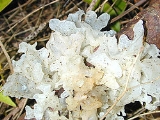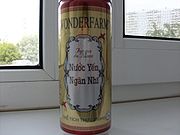
Snow fungus
Encyclopedia
Tremella fuciformis is a species
of fungus
producing white, frond-like, gelatinous basidiocarps (fruit bodies). It is widespread, especially in the tropics
, and is parasitic on other fungi (Hypoxylon
species), that grow on dead attached and recently fallen branches of broadleaf trees. Fruitbodies are commercially cultivated for use in Chinese cuisine
and Chinese medicine. Tremella fuciformis has been given the common names snow fungus or silver ear fungus.
, based on collections made in Brazil
by the botanist and explorer Richard Spruce
.
In 1939, Japanese mycologist Yosio Kobayasi described Nakaiomyces nipponicus, a similar-looking fungus that differed by having scattered, dark spines on its surface. Later research, however, showed that the fruit bodies were those of Tremella fuciformis parasitized by an ascomycete, Ceratocystis epigloeum, that formed the dark spines. Nakaiomyces nipponicus is therefore a synonym of T. fuciformis.
and occur in a dense gelatinous matrix. Haustorial cells arise on the hyphae, producing filaments that attach to and penetrate the hyphae of the host. The basidia are tremelloid (ellipsoid, with oblique to vertical septa), 10-13 by 6.5-10 μm, sometimes stalked. The basidiospores are ellipsoid, smooth, 5-8 by 4-6 μm, and germinate by hyphal tube or by yeast
cells.
The species is mainly tropical and subtropical, but extends into temperate areas in Asia and North America. It is known throughout South and Central America, the Caribbean, parts of North America, sub-Saharan Africa, southern and eastern Asia, Australia, New Zealand, and the Pacific Islands.
 Tremella fuciformis has been cultivated in China since at least the nineteenth century. Initially, suitable wooden poles were prepared and then treated in various ways in the hope that they would be colonized by the fungus. This haphazard method of cultivation was improved when poles were inoculated with spores or mycelium. Modern production only began, however, with the realization that both the Tremella and its host species needed to be inoculated into the substrate to ensure success. The "dual culture" method, now used commercially, employs a sawdust mix inoculated with both fungal species and kept under optimal conditions. Estimated production in China in 1997 was 130,000 tonnes. Tremella fuciformis is also cultivated in other East Asian countries, with some limited cultivation elsewhere.
Tremella fuciformis has been cultivated in China since at least the nineteenth century. Initially, suitable wooden poles were prepared and then treated in various ways in the hope that they would be colonized by the fungus. This haphazard method of cultivation was improved when poles were inoculated with spores or mycelium. Modern production only began, however, with the realization that both the Tremella and its host species needed to be inoculated into the substrate to ensure success. The "dual culture" method, now used commercially, employs a sawdust mix inoculated with both fungal species and kept under optimal conditions. Estimated production in China in 1997 was 130,000 tonnes. Tremella fuciformis is also cultivated in other East Asian countries, with some limited cultivation elsewhere.
In Chinese cuisine, Tremella fuciformis is traditionally used in sweet dishes. While tasteless, it is valued for its gelatinous texture as well as its supposed medicinal benefits. Most commonly, it is used to make a dessert soup
called luk mei (六味), often in combination with jujube
s, dried longan
s, and other ingredients. It is also used as a component of a drink and as an ice cream. Since cultivation has made it less expensive, it is now additionally used in some savoury dishes.
In Chinese, it is called 银耳 (pinyin: yín ěr; literally "silver ear"), 雪耳 (pinyin: xuě ěr; literally "snow ear"); or 白木耳 (pinyin: bái mù ěr, literally "white wood ear
") , and in Japanese it is called shiro kikurage (シロキクラゲ, lit. "white tree jellyfish") . In Vietnam
, it is called nấm tuyết or ngân nhĩ .
Species
In biology, a species is one of the basic units of biological classification and a taxonomic rank. A species is often defined as a group of organisms capable of interbreeding and producing fertile offspring. While in many cases this definition is adequate, more precise or differing measures are...
of fungus
Fungus
A fungus is a member of a large group of eukaryotic organisms that includes microorganisms such as yeasts and molds , as well as the more familiar mushrooms. These organisms are classified as a kingdom, Fungi, which is separate from plants, animals, and bacteria...
producing white, frond-like, gelatinous basidiocarps (fruit bodies). It is widespread, especially in the tropics
Tropics
The tropics is a region of the Earth surrounding the Equator. It is limited in latitude by the Tropic of Cancer in the northern hemisphere at approximately N and the Tropic of Capricorn in the southern hemisphere at S; these latitudes correspond to the axial tilt of the Earth...
, and is parasitic on other fungi (Hypoxylon
Hypoxylon
Hypoxylon is a genus of Ascomycetes commonly found on dead wood, and usually one of the earliest species to colonise dead wood. A common European species is Hypoxylon fragiforme which is particular common on dead trunks of beech.-External links:*...
species), that grow on dead attached and recently fallen branches of broadleaf trees. Fruitbodies are commercially cultivated for use in Chinese cuisine
Chinese cuisine
Chinese cuisine is any of several styles originating in the regions of China, some of which have become highly popular in other parts of the world – from Asia to the Americas, Australia, Western Europe and Southern Africa...
and Chinese medicine. Tremella fuciformis has been given the common names snow fungus or silver ear fungus.
Taxonomy
Tremella fuciformis was first described in 1856 by English mycologist Miles Joseph BerkeleyMiles Joseph Berkeley
Miles Joseph Berkeley was an English cryptogamist and clergyman, and one of the founders of the science of plant pathology....
, based on collections made in Brazil
Brazil
Brazil , officially the Federative Republic of Brazil , is the largest country in South America. It is the world's fifth largest country, both by geographical area and by population with over 192 million people...
by the botanist and explorer Richard Spruce
Richard Spruce
Richard Spruce was an English botanist. One of the great Victorian botanical explorers, Spruce spent approximately 15 years exploring the Amazon from the Andes to the mouth, and was one of the first Europeans to visit many of the places where he collected specimens.The plants and objects collected...
.
In 1939, Japanese mycologist Yosio Kobayasi described Nakaiomyces nipponicus, a similar-looking fungus that differed by having scattered, dark spines on its surface. Later research, however, showed that the fruit bodies were those of Tremella fuciformis parasitized by an ascomycete, Ceratocystis epigloeum, that formed the dark spines. Nakaiomyces nipponicus is therefore a synonym of T. fuciformis.
Description
Fruit bodies are gelatinous, watery white, up to 7.5 cm (3 ins) across (larger in cultivated specimens), and composed of thin but erect, seaweed-like, branching fronds, often crisped at the edges. Microscopically, the hyphae are clampedClamp connection
A clamp connection is a structure formed by growing hyphal cells of certain fungi. It is created to ensure each septum, or segment of hypha separated by crossed walls, receives a set of differing nuclei, which are obtained through mating of hyphae of differing sexual types...
and occur in a dense gelatinous matrix. Haustorial cells arise on the hyphae, producing filaments that attach to and penetrate the hyphae of the host. The basidia are tremelloid (ellipsoid, with oblique to vertical septa), 10-13 by 6.5-10 μm, sometimes stalked. The basidiospores are ellipsoid, smooth, 5-8 by 4-6 μm, and germinate by hyphal tube or by yeast
Yeast
Yeasts are eukaryotic micro-organisms classified in the kingdom Fungi, with 1,500 species currently described estimated to be only 1% of all fungal species. Most reproduce asexually by mitosis, and many do so by an asymmetric division process called budding...
cells.
Habitat and distribution
Tremella fuciformis is known to be a parasite of Hypoxylon species, including Hypoxylon archeri, the species routinely used in commercial cultivation. Following its host, fruit bodies are typically found on dead, attached or recently fallen branches of broadleaf trees.The species is mainly tropical and subtropical, but extends into temperate areas in Asia and North America. It is known throughout South and Central America, the Caribbean, parts of North America, sub-Saharan Africa, southern and eastern Asia, Australia, New Zealand, and the Pacific Islands.
Economic usage

In Chinese cuisine, Tremella fuciformis is traditionally used in sweet dishes. While tasteless, it is valued for its gelatinous texture as well as its supposed medicinal benefits. Most commonly, it is used to make a dessert soup
Tong Sui
Tong sui, also known as tim tong, is a collective term for any sweet, warm soup or custard served as a dessert at the end of a meal in Cantonese cuisine. Tong sui are a Cantonese specialty and are rarely found in other regional cuisines of China...
called luk mei (六味), often in combination with jujube
Jujube
Ziziphus zizyphus , commonly called jujube , red date, Chinese date, Korean date, or Indian date is a species of Ziziphus in the buckthorn family Rhamnaceae, used primarily as a fruiting shade tree.-Distribution:Its precise natural distribution is uncertain due to extensive cultivation,...
s, dried longan
Longan
Dimocarpus longan, commonly known as the longan, is a tropical tree native to South and Southeast Asia, in the Indomalaya ecozone known for its edible fruit.-Vernacular names:The fruit is known as longan or longyan in English...
s, and other ingredients. It is also used as a component of a drink and as an ice cream. Since cultivation has made it less expensive, it is now additionally used in some savoury dishes.
In Chinese, it is called 银耳 (pinyin: yín ěr; literally "silver ear"), 雪耳 (pinyin: xuě ěr; literally "snow ear"); or 白木耳 (pinyin: bái mù ěr, literally "white wood ear
Wood ear
Wood ear, or 木耳 , can refer to two different closely related species of edible fungus used primarily in Asian cuisine; these are commonly sold in Asian markets shredded and dried....
") , and in Japanese it is called shiro kikurage (シロキクラゲ, lit. "white tree jellyfish") . In Vietnam
Vietnam
Vietnam – sometimes spelled Viet Nam , officially the Socialist Republic of Vietnam – is the easternmost country on the Indochina Peninsula in Southeast Asia. It is bordered by China to the north, Laos to the northwest, Cambodia to the southwest, and the South China Sea –...
, it is called nấm tuyết or ngân nhĩ .

